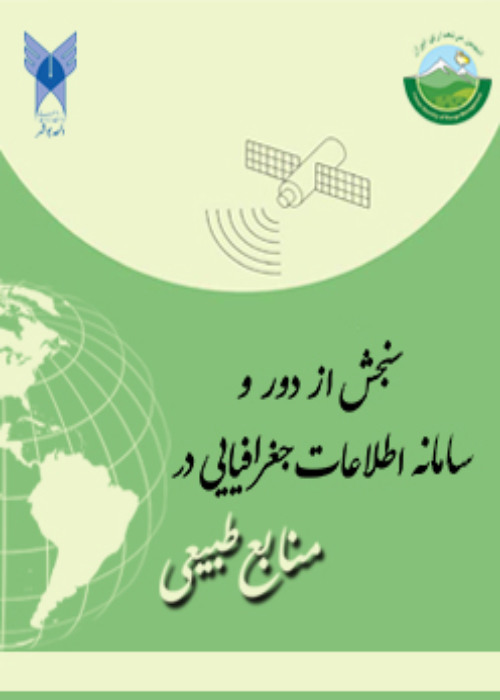Vegetation classification based on wetland index using object based classification of satellite images (Case study: Anzali wetland)
Recently, a lot of studies have been done in Anzali wetland as one of the most important wetlands of Ramsar Convention, which has a high cost due to the nature and geographical location of the wetland. Advances in technology have made it possible to evaluate natural environments more accurately, fast, and low cost with remote sensing data due to their easy accessibility, high accuracy, extensive and reproducible coverage in terms of time and space, and information extraction in a relatively short time. Because one of the most important problems in studying vegetation changes is the lack of accurate spatial information over time. Satellite imagery and remote sensing technology make it possible to achieve a better program for environmental management by relying on the information produced by it. In this study, the vegetation classification of Anzali wetland was done by using the technique of Object base classifications of Landsat image incorporation with fieldwork based on the wetland index of plants as well as the vegetation index (NDVI) of the study area were analyzed. Wetland vegetation classification maps can be used to identify the amount and type of cover and planning to maintain and rehabilitate the wetland.
In this study, a vegetation map based on the wetland index is considered as one of the required criteria for ecological demarcation of wetlands. First, the general vegetation areas of the wetland on the coast and around it were identified. Then, vegetation data of wetland aquatic species were collected from different wetland areas in 0.25 m2 plots. In the land margin area, the wetland species of the wetland margin were collected with a 1 m2 plot. A total of 42 plots were collected during the spring and summer of 2019. After preparing the required images, their preprocessing including geometric, atmospheric, radiometric corrections and image enhancement were performed using ENVI. Landsat 8 Image on July 29, 1998, with a spatial resolution of 30 meters was used to classify vegetation and prepare a map of vegetation index (NDVI) and image of Sentinel-2 satellite (July 98) due to 10 m of the ground resolution was used to combine with Landsat 8 data as auxiliary data in image classification. The combining of these two images improves the spatial resolution also preserves the spectral values of the multispectral image. The object-based classification was performed on the integrated Landsat 8 image using training data from field work. The classification accuracy was evaluated for each class using experimental samples as ground control points and the classification error matrix was extracted.
First, the dominant plants and representatives of their wetland index were identified by field work. Then, the relative percentage of dominant plant cover at the sampling site was calculated according to the standard list of identified plant species, and Plants were divided into two groups of wetland and non-wetland based on the wetland index. From the classification of plot species in 42 plots, 180 plant species were identified in 124 genera and 48 families. Also, four groups of wetland plants were: obligate wetland plants (OBL), facultative and obligate wetland plants (OBL & FACW), facultative upland, and facultative wetland plants (FACU & FACW), and facultative wetland plants (FACW). A vegetation map was prepared from a combination of terrestrial samples and object base classification of the 2019 Landsat satellite OLI image sensor. The accuracy of the classified maps was evaluated based on the kappa coefficient and overall accuracy. The overall accuracy is 88.62% and the kappa coefficient is 84%. The Plant distribution was determined based on satellite image classification: OBL plants were observed in the water zone (west and Sorkhankol wetland margin), FACW plants were observed mostly in the dry margin and mainly in the southwest of the wetland (Siahkeshim wetland) and Choukam Wildlife Sanctuary in the eastern part of the wetland, OBL & FACW group with less uniform distribution was observed in the whole area and FACU & FACW group was observed in a small part in Choukam, north, and northwest of the wetland. The percentage of vegetation density map retrieved from the NDVI index shows the distribution of dense vegetation cover in different parts of the wetland and the limitation of the water level of the wetland bed.
The results of the satellite imagery study and their classification according to terrestrial samples showed that the spread and dispersal of obligate wetland species (OBL) were limited to water parts of the wetlands so that the highest distribution of these plants were in the west of the Anzali wetland and Sorkhankol. The spread of facultative wetland species (FACW) was in the arid areas of the wetland, which indicates the upland areas of the wetland in Siahkeshim (southwest) and Choukam (east). The result of image classification showed the percentage of plant group in each class: the agricultural class (with a present level of 23.9%) and the group of facultative species (FACW) (with a present level of 23.6% and mostly Phragmites, Alnus, and Salix species) have the top percentage of image classification classes of Anzali Wetland. This indicates more presence of facultative species compared to obligate species of wetland (OBL) (with a present level of 10.1%) and the level of agricultural land occupation, showed the wetland drying. The percentage of vegetation at the wetland level was assessed with the vegetation index (NDVI), most of which belongs to dense vegetation. Due to the fact that the satellite image is related to the summer season, this map shows the distribution of vegetation in different parts and the water level of the wetland bed, which has reduced the amount of water levels in the wetland. Periodic review of vegetation and its ecological changes provides useful information on changes in the water and ecological resources of the wetland to plan for its maintenance as an important ecosystem in the region.
- حق عضویت دریافتی صرف حمایت از نشریات عضو و نگهداری، تکمیل و توسعه مگیران میشود.
- پرداخت حق اشتراک و دانلود مقالات اجازه بازنشر آن در سایر رسانههای چاپی و دیجیتال را به کاربر نمیدهد.



